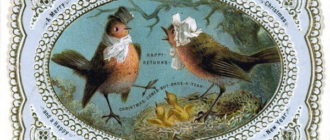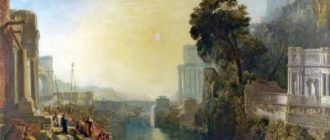- Painting The Last Day of Pompeii by Karl Bryullov the beauty and grandeur of nature against the background of the tragedy of the ancient world
- In the foreground on the right is a mother with two daughters looking up in despair.
- Karl Bryullov is a famous Russian artist, a bright representative of classicism and romanticism in 19th century painting.

Painting The Last Day of Pompeii by Karl Bryullov the beauty and grandeur of nature against the background of the tragedy of the ancient world
The Last Day of Pompeii is a painting by the famous Russian artist Karl Pavlovich Briullov, is considered the central work in his work. The large-scale canvas depicts a tragic episode from ancient Roman history the eruption of Mount Vesuvius and the destruction of the city of Pompeii in 79 AD. NS.
The picture is symbolic and multifaceted. In contrast to the traditions of classicism, the plot is based not on the story of one hero, but on the tragedy of an entire people. In the center of the Street of the Tombs, we see a dead woman who has fallen from a chariot, to which her child is clinging. On the left is a young man holding his mother’s hand to his chest. Here are the sons carrying their wounded father.
In the foreground on the right is a mother with two daughters looking up in despair.
The once rich city is filled with rubble of houses, public buildings, destroyed statues of gods. Residents running in panic gaze in horror at the blood-red sky, covering themselves with their hands, unsuccessfully trying to escape from the wrath of nature.
At first glance, the viewer is presented with a terrifying picture of a destructive, uncontrollable element. Bursts of fire bursting through heavy clouds, killing all living black ash and people, enveloped in the horror of an imminent end. The depicted figures are not static, they are in motion, their faces are full of fear of imminent death.
One gets the impression that the artist personally caught the crowd at a terrible moment, the feelings of doomed people are so realistically conveyed. When constructing the composition, Bryullov adhered to academic canons: the characters are distributed into groups, the figures in the foreground resemble sculptures in texture and are contrasted with the two-dimensional traced silhouettes of people behind. The dynamics of the plot are recreated by alternating dark, dense tones in the center and faded ones in the background. Thus, the author was able to convey the lighting from the volcano and lightning flashes in different ways. Author: Karl Bryullov (1799-1852).
Year of writing: 1827-1833
Dimensions: 456.5 x 651 cm.
Style: Romanticism.
Genre: Historical plot.
Technique: Oil painting.
Material: Canvas.
Location: State Russian Museum in St. Petersburg.
Karl Bryullov is a famous Russian artist, a bright representative of classicism and romanticism in 19th century painting.
The impetus for writing the work “The Last Day of Pompeii” was the passionate letters of his brother Alexander. For almost two years he made sketches of structures on excavations in Italy, it was his impressions that suggested to Karl Bryullov the plot of the future picture.
In 1927, the master spent four days in the ruins of Pompeii. He was so greatly impressed by the atmosphere of this place that he immediately planned to paint a large-scale painting with a multi-figured composition and depict the death of ancient civilization on it. The idea was picked up by Anatoly Demidov, a diplomat and a famous Russian philanthropist, who also ordered the work.
In the process of work, the artist scrupulously studied historical documents and eyewitness accounts of the tragedy. Thus, the letters of Pliny the Younger (Gaius Plinius Caecilius Secundus) to Tacitus (Publius Cornelius Tacitus) became the source of the birth of one of the central images. It took three years to write sketches and sketches, and only in 1830 the painter began to compose and draw all the elements.
The work was completed in the fall of 1833.
For the first time, the painting “The Last Day of Pompeii” was exhibited in the studio of the author of Via di San Claudio in Rome and literally blew up the artistic world. The outstanding personalities of our time came to look at the epic masterpiece of the Russian master of painting.
Karl Bryullov’s popularity in Europe grew every day. In 1834 Demidov solemnly presented the painting to Emperor Nicholas I, who handed it over to the Hermitage, where the work was exhibited for all to see. In 1987, The Last Day of Pompeii was transferred to the Russian Museum for safekeeping. The painting is here to this day.






